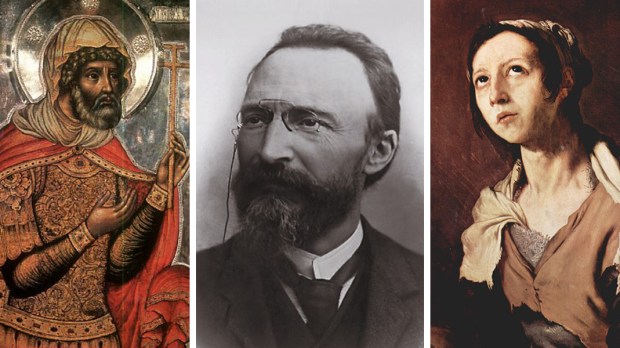When Jesus appeared to St. Faustina Kowalska, he spoke of his never-ending mercy. But the overwhelming mercy of God wasn’t a 20th-century revelation; no, the Church has known from the beginning that God’s love is so great as to call even the vilest of sinners to holiness. Still, it’s easy to feel so ashamed of the sins of our past (or the sins we can’t seem to escape even now) that we begin to believe that God couldn’t possibly make us holy. As we celebrate Divine Mercy this week, let’s look to the saints whose sins remind us that we, too, can be transformed by grace into saints whose lives give glory to God.
St. Longinus (1st century) gives hope to even the worst of sinners. If the man who killed God with his own two hands can be a saint, anyone can. Longinus is the name ascribed to the Roman centurion who stabbed Jesus’ body with his spear to ascertain that the Lord was truly dead. Having seen the manner in which Jesus had died, he cried out, “Truly this man was the Son of God!” Later tradition asserts that Longinus was converted in that moment. After being baptized, he became a great evangelist, preaching the good news of the one he had helped to kill.
St. Mary of Egypt (344-421) is often called a prostitute, but she didn’t accept money for her services. No, Mary was a nymphomaniac, a woman so consumed by desire for carnal pleasure that she sometimes even compelled men against their will. It’s hard to imagine the redemption of a nymphomaniac and a rapist, but God didn’t define Mary by her sin. Having made a pilgrimage to the Holy Land (for the challenge of seducing all the pilgrims on the way), Mary was suddenly convicted of the wickedness of her sin. She repented and fled to the desert, where she continued to struggle against sin and shame and temptation. For 17 years she had lived according to the flesh and for 17 years she fought not to be consumed again by her passions. Finally, she was set free and lived the rest of her life without temptation, a hermit in the desert who became one of the greatest saints of the Eastern Church.
St. Olga of Kiev (d. 969) was a mass murderer. Queen of the Kievan Rus’, she defended her crown by murdering her enemies en masse, once besieging a city and burning it to the ground when its people surrendered. Olga was baptized when on a political visit to Constantinople, perhaps as an attempt to gain power among the other Christian rulers in the area. Whatever her intentions, her baptism utterly transformed her. She spent the rest of her life failing to make up for the damage she had done, particularly in the temperament of the son she had raised to be ruthless. She invited missionaries to her country, but they were largely unsuccessful. After Olga’s death, though, her intercession wrought the miraculous healing of her grandson, St. Vladimir the Great, who brought the Russian people to Christ. For her role, she’s known as Equal to the Apostles in the Byzantine Church.
St. Bruno Sserunkuuma (~1856-1886) was an arrogant, violent, and stubborn bigamist, prone to drunkenness and lechery. Though he longed for holiness and chose to be baptized as an adult, Sserunkuuma found that the Sacrament hadn’t magically removed his inclinations to sin. He still used extortion when his work as a royal guard required him to collect taxes. And when the king gave him two young women as a sort of prize, Sserunkuuma’s attempts at chastity went out the window. He took them both as his wives (though neither was a valid marriage) and soon one of the women was pregnant. Mercifully, Sserunkuuma’s friends St. Charles Lwanga and St. Andrew Kaggwa were disturbed at his behavior and confronted him, issuing fraternal correction so convicting that Sserunkuuma separated from both women. He left them in his home and made something of a monastic cell for himself in the palace, where he lived after making a good confession. Though he wasn’t known to be a Christian, when the persecution of Christians began, he confessed that he was a Christian and was burned to death.
Blessed Bartolo Longo (1841-1926) was a high priest of Satan before his conversion. Though raised praying the Rosary, Bartolo was eager to live the college experience fully, which at the time meant anti-clericalism, atheism, and ultimately the occult. Before long he was “ordained” a priest of Satan. Through the intercession of his deceased father, Bartolo finally returned to God and renounced Satanism, though it took some time for him to accept that God had truly forgiven him. For more than 50 years after that, Bartolo preached the Rosary, founded schools for the poor, and established orphanages for the children of criminals.

Read more:
Augustine, Pelagia, and other sinners who became great saints

